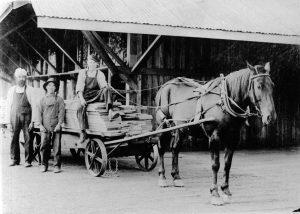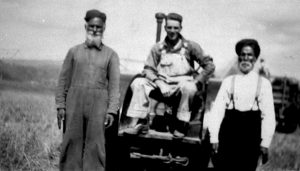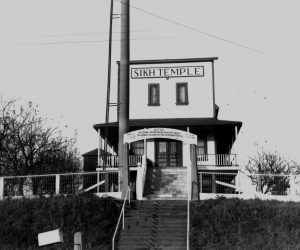Life at the mill was hard work. The Abbotsford Lumber Company’s migrant employees did difficult, and often monotonous jobs; however, on site they lived normal lives, and were treated relatively similarly to the white European workers. They had lodgings, cooks, and some were even allowed to have their families on site. The relationships formed at the mill resulted in a more diverse Abbotsford, by allowing migrant communities to grow roots, and make the city their home.
AT WORK
A life in the lumber industry was difficult. Each step in the process from cutting down the tree, to shipping out the stock was physically demanding work. Although jobs at the Abbotsford Lumber Company weren’t specifically distributed based on ethnicity, the Japanese, Chinese, and Sikh employees at the mill tended to have low skilled, and sometimes dangerous jobs. The more technical tasks were assigned primarily to white-settler employees. The actual labour camps in the forests around Abbotsford, where the trees were felled, were manned primarily by white labour.1 Back on the lake, the rest of the mill’s employees prepared the logs to be made into sellable product. One of the first steps upon arrival of the unprocessed timber was sorting the different types of wood, which was done using log booms. Log booms are essentially a collection point in the water for logs to be sorted, and working this job was very hazardous, as being crushed, or falling into the lake and drowning was a real possibility. At the Abbotsford mill, on the west end of the lake, the Japanese employees were given this difficult task,2 along with other low skilled jobs around the site. A slightly less dangerous, but certainly no less physically demanding task was the piling of lumber, which the Chinese and Sikh employees did. These jobs required minimal skill but were guaranteed to tire a man out, and the employees’ work was absolutely essential to the running of the mill.

Employees of the Abbotsford Lumber Company in 1915. Left to Right: Lob Singh, unidentified employee, and G.M. Zeigler. Photo courtesy of The Reach Gallery Museum. P11927.
AT REST
Unlike nowadays, where most people drive home at the end of a long day of work, the employees at the Abbotsford Lumber Company lived on site. The company paid for bunkhouses for the Chinese, Japanese and Sikh workers, who were mostly single men; however, some of the Japanese employees had families, who were provided with cottages nearby on site. Each ethnic community was provided with a cook, and there was even a unisex Japanese bathhouse for the employees to use. However, not all employees were treated equally by the company. The Chinese workers, as part of the agreement made with recruiting agent Charlie Yung, were charged 20 cents for every hour of their labour, as well as food costs, and they weren’t allowed to receive pay cheques until their contracts had been fulfilled.3 Mary Harvey, whose father worked at the mill, remembers seeing the Chinese employees every Sunday, where they would all be outdoors with tubs and scrub boards washing their clothing for the next week’s work.4 Although treatment wasn’t fair between the different ethnic communities working at the mill, this chore represents a common task among all the workers.

Sunder Singh Thandi (Right) on his farm with Hari Singh (right) and permanent employee Ben Ratzlaff in 1938. Photo Courtesy of The Reach Gallery Museum. P11919.
The Sikh employees at the mill established more permanent roots in Abbotsford at the end of their shifts by building the Gur Sikh Temple, the oldest standing Sikh temple in Canada, and now a Canadian National Heritage site. Mill employees Sunder Singh Thandi, who would eventually become foreman of a small crew at the lumber company,5 and Arjan Singh purchased a one-acre lot near the mill as the site for the Gurdwara’s construction.6 After work, the Sikh employees at the mill would carry the lumber up the hill to the site, and by 1911, the temple construction was complete. Its grand opening in 1912 was attended by Sikh, and European-

The Gur Sikh Temple on South Fraser Way, photograph taken 1947. Located north of the mill. Photo courtesy of The Reach Gallery Museum. N294.
descent residents of Abbotsford. In white-settler media at the time, essentially all migrants from India were labelled Hindu, and although this was certainly not the case, the Abbotsford Sumas and Matsqui News subscribed to this common terminology. Despite the incorrect use of the name, the newspaper’s report of the temple and its opening were quite favourable. The writer praised the “highly intelligent address delivered by Priest Taja Singh,” and commented on the quality of the building and its decorations.7 It is clear that there were members of the white settler society in Abbotsford who were supporters of this early Indo-Canadian community in British Columbia. The Abbotsford Lumber Company, by providing steady employment, allowed the Sikh community to cultivate a new life in Canada, making them one of Abbotsford’s early pioneer groups.
NEXT PAGE → TENSION IN TOWN
NOTES
1. “Among Fraser Valley’s Premier Industries: Prosperity of Abbotsford Largely Due to Local Mill Company-Employs 230 Men,” Pacific Coast Lumberman, March 1920, The Reach Gallery Museum.
2. Clarke Trethewey, interview, August 22, 1985. The Reach Gallery Museum.
3. Clarke Trethewey, interview, August 22, 1985. The Reach Gallery Museum.
4. Mary Harvey, Interview regarding the Abbotsford Lumber Company, interviewed by Mona Fedatos, December 12, 1975. The Reach Gallery Museum, Folder: Abbotsford Lumber Company.
5. Sherwood, Philip ed., Matsqui Sumas Abbotsford: Pioneer Stories 1890-1950 (Abbotsford: MSA Museum Society, 2013), 319.
6. Bains and Sandhra, “Sustaining Echoes of the Past,” 124.
7. “Opening of the Hindoo Temple,” Abbotsford Sumas and Matsqui News, March 1, 1912. The Reach Gallery Musuem.